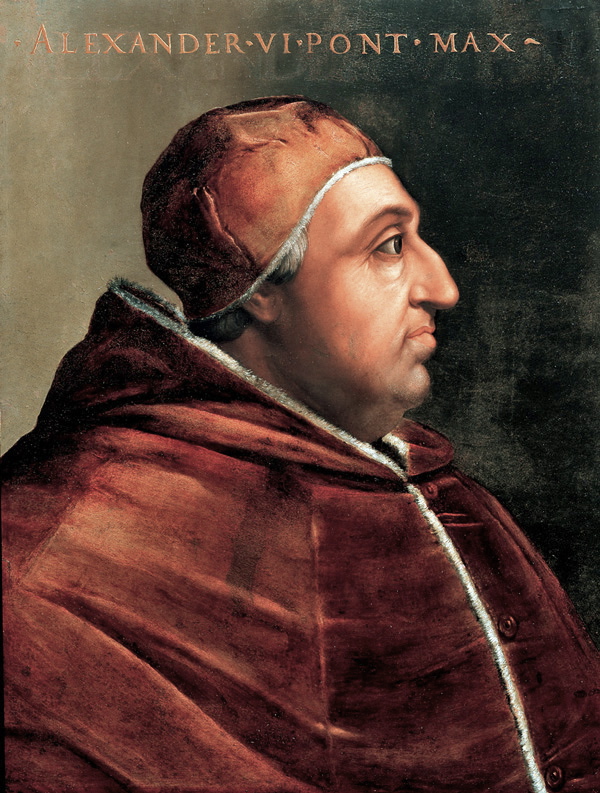Note: Dario Fo was WINNER of the Nobel Prize for Literature in 1997, though he had never written a book. Instead, he was recognized by the Nobel Committee for his more than forty plays, his acting, his directing and his “emulation of the jesters of the Middle Ages in scourging authority and upholding the dignity of the downtrodden.” This biographical novel is his first novel.
“If we remove the story of Pope Alexander VI and his family from its context in Renaissance Italy, what we get is a shocking saga in which all the leading characters act without regard for their adversaries and quite often each other. At every twist and turn, the victim destined for sacrifice, ever since she was a child is Lucrezia. It is she who is tossed into the gaping maw of financial and political interests by both her father and her brother, without a qualm. What the lovely young maiden might think or feel is of no concern. After all, she’s just a female…”—from “Jumping feet-first into the mud,” the Preamble to the novel.
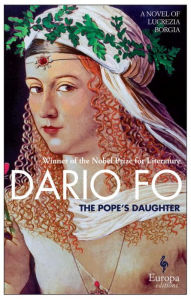 Over the years, Italian author Dario Fo has made no secret of the fact that he believes that Lucrezia Borgia (1480 – 1519), the illegitimate daughter of Pope Alexander VI, does not deserve her murderous reputation of more than five hundred years. Her father, the Pope, formerly known as Rodrigo Borgia, was often manipulative, acting in response to the changing political landscape, and Lucrezia’s brother Cesare, also the Pope’s son, was even more self-serving – a murderer of anyone in his path to success. Fo believes that Lucrezia was not only intelligent and incisive in her insights into politics, but also innocent of the crimes which have made the Borgia name synonymous with treachery and danger. Still considered by many students of the Italian Renaissance to be a power-hungry madwoman, a poisoner of her enemies, and a lover of her brother, Lucrezia Borgia gains new respect in this sympathetic portrait by Fo, who admires her insights into the nature of power and how it may be used to benefit society – as well as herself.
Over the years, Italian author Dario Fo has made no secret of the fact that he believes that Lucrezia Borgia (1480 – 1519), the illegitimate daughter of Pope Alexander VI, does not deserve her murderous reputation of more than five hundred years. Her father, the Pope, formerly known as Rodrigo Borgia, was often manipulative, acting in response to the changing political landscape, and Lucrezia’s brother Cesare, also the Pope’s son, was even more self-serving – a murderer of anyone in his path to success. Fo believes that Lucrezia was not only intelligent and incisive in her insights into politics, but also innocent of the crimes which have made the Borgia name synonymous with treachery and danger. Still considered by many students of the Italian Renaissance to be a power-hungry madwoman, a poisoner of her enemies, and a lover of her brother, Lucrezia Borgia gains new respect in this sympathetic portrait by Fo, who admires her insights into the nature of power and how it may be used to benefit society – as well as herself.
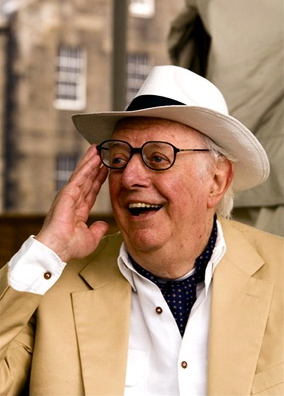 As his main characters travel to various seats of power throughout late fifteenth century Italy, Fo’s series of vignettes, set within many changes of time and scenery, immediately establish an iconoclastic approach to Lucrezia Borgia’s story, which bears little resemblance to a classically structured and plotted historical novel and even less to a serious research paper, despite Fo’s bibliography at the end. The Pope’s Daughter begins, in fact, with a Preamble which Fo entitles “Jumping feet-first into the mud,” immediately establishing a relaxed, conversational tone, which is further enhanced by the author’s own painted variations of period portraits which provide a fresher, more modern perspective on the characters. Throughout, the author chats with the reader, explaining in often colloquial language what is happening, which makes the story feel more comfortable than it might be otherwise, and allows the reader to see obvious parallels between what is happening in the late 1400s throughout Italy and what is happening in present day international politics.
As his main characters travel to various seats of power throughout late fifteenth century Italy, Fo’s series of vignettes, set within many changes of time and scenery, immediately establish an iconoclastic approach to Lucrezia Borgia’s story, which bears little resemblance to a classically structured and plotted historical novel and even less to a serious research paper, despite Fo’s bibliography at the end. The Pope’s Daughter begins, in fact, with a Preamble which Fo entitles “Jumping feet-first into the mud,” immediately establishing a relaxed, conversational tone, which is further enhanced by the author’s own painted variations of period portraits which provide a fresher, more modern perspective on the characters. Throughout, the author chats with the reader, explaining in often colloquial language what is happening, which makes the story feel more comfortable than it might be otherwise, and allows the reader to see obvious parallels between what is happening in the late 1400s throughout Italy and what is happening in present day international politics.
Lucrezia Borgia, age twelve, and Cesare Borgia, age sixteen, when their “uncle,” Cardinal Rodrigo Borgia, ascends to the Papacy, become the linchpins of this novel of battles, betrayals, murders, and massacres. Rodrigo Borgia has hidden his role as the father of these and two other children, and it is only his election as Pope which leads him to his acknowledge his paternity, and eventually to appoint his son Cesare to his position as an archbishop in Valencia. Lucrezia, at thirteen, is married off to Giovanni Sforza, an arranged marriage which lasts only until someone finds him “inconvenient.” Italy is fighting off constant threats to independent rule from Spain and France, and with the perpetual infighting among the various dukes who control the major cities of Italy – Venice, Florence, Milan, Ferrara, Naples – no one can ever be quite sure who is a friend and who is dedicated to usurping someone else’s rule.
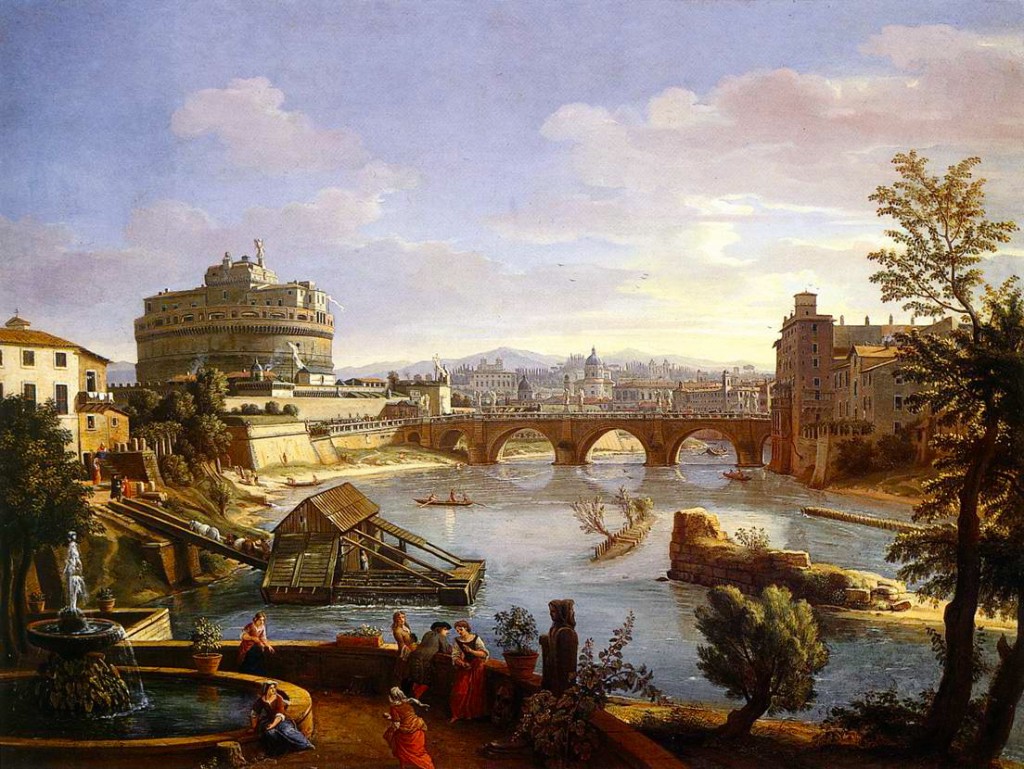
“On August 11, 1492, the artillery of Castel Sant’Angelo were fired to remind Rome and the world that a new pontiff had been elected…Alexander VI.” Castel Sant’Angelo , the round building on the left side, was the place where Hadrian was entombed in A.D.138. The painting is by Caspar Van Wittel (1653 – 1746).
Two more marriages and a couple of affairs to powerful men eventually lead Lucrezia to Ferrara, where she plans to avoid most of the horrors of Roman politics. Here she can act as a patron of famous artists while also helping her father, the Pope, in some of his efforts to combat corruption. As a Vicaress, she addresses the College of Cardinals and at one point acts on behalf of the Pope in his absence, and the author clearly believes that she has acted with good intentions and has not been associated with the actions of her brother. Cesare Borgia, by contrast, is the model for Machiavelli’s The Prince, a man who acts expediently and allies himself with whoever can help him advance his own political and financial agendas. He plays upon his father’s position in his relationships with military leaders and uses that connection to advance his own career. There are hints that he even has a hand in his younger brother’s murder and in the massacre of many leaders from other influential families whom he invited to a meeting in which they would all discuss peace but from which no one else would survive.
The death of Pope Alexander II and the eventual election of the Borgias’ bitterest enemy, who became known as Julius II, signals the beginning of the end for Cesare, who is now “simply a political annoyance, and therefore has to be eliminated.” Lucrezia shows her true colors when she raises an army of mercenaries to fight the Venetians, a move which leads famed poet Pietro Bembo, who loves her, to say, “You sound like a soldier of fortune organizing an army! You’re extraordinary, Lucrezia, your life is a shining example, a great and lasting lesson for me!”
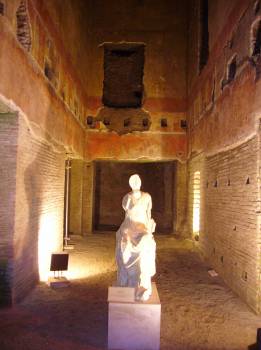
Built between 64 and 68 A.D. by the Emperor Nero, this residence was thought so extravagant that his successors stripped it of its valuables and buried it under tons of rubble. Rediscovered during the Renaissance, the Domus Aurea excited Lucrezia Borgia when she visited it with her father.
With a plot abbreviated to the point that most readers will have some questions at the end of the action regarding exactly who did what to whom and why, Dario Fo has succeeded in creating a real but flawed person out of the information he presents. Few readers will fail to see parallels between this political action and its on-going warfare, and similar behavior and political activity in the present day, and the insights into Machiavellian intrigue on the grand scale which we see here with Cesare Borgia will stick in the reader’s mind especially for its contrast with the late-in-life behavior of Lucrezia herself and her own surprising conclusion: “I hope that this life will make you think festively of the wonder of being alive.”
Photos, in order: The author’s photo appears on http://www.vogue.it/
The photo of Alexander VI, Rodrigo Borgia, is found here: https://en.wikipedia.org/
Castel Sant’Angelo, by Guiseppe Zocchi. “On August 11, 1492, the artillery of Castel Sant’Angelo were fired to remind Rome and the world that a new pontiff had been elected…Alexander VI.” Castel Sant’Angelo was the place where Hadrian was entombed in A.D.138. It is the round building on the left side, by Caspar Van Wittel (1653 – 1746).
The portrait of Cesare Borgia, by Altobello Mellone, is seen here: https://en.wikipedia.org
Lucrezia meets her father secretly at the Domus Aurea after refusing to go to Rome because she did not want to see her brother Cesare. It had been recently uncovered after being buried for 1500 years. https://en.wikipedia.org/
ARC: Europa
